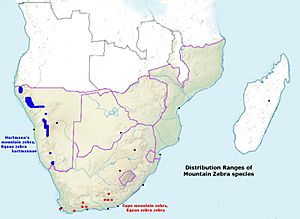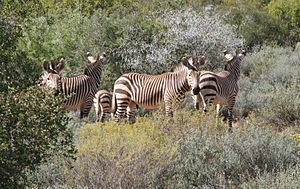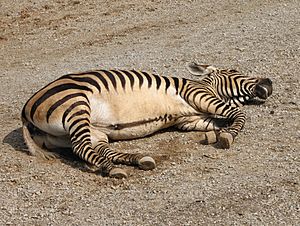Mountain zebra facts for kids
Quick facts for kids Mountain zebra |
|
|---|---|
 |
|
| Hartmann's mountain zebra (E. zebra hartmannae) in Etosha National Park, Namibia | |
| Conservation status | |
| Scientific classification | |
| Genus: |
Equus
|
| Species: |
zebra
|
| Subspecies | |
see text |
|
 |
|
| Range map of Equus zebra zebra in red and Equus zebra hartmannae in blue | |
The mountain zebra (Equus zebra) is a special type of zebra that belongs to the horse family, Equidae.
These zebras live in the wild in south-western Angola, Namibia, and South Africa.
Contents
Types of Mountain Zebras
The mountain zebra actually comes in two main types, called subspecies:
- The Cape mountain zebra (E. z. zebra)
- The Hartmann's mountain zebra (E. z. hartmannae)
What Do Mountain Zebras Look Like?
Mountain zebras have a loose flap of skin under their throat, called a dewlap. This dewlap is easier to see on the Cape mountain zebra than on Hartmann's mountain zebra.
Like all zebras, mountain zebras have bold black or dark brown stripes. No two zebras have the exact same stripe pattern, just like human fingerprints! Their whole body is striped, except for their belly, which is usually white. The Cape mountain zebra has a mostly white background color, while Hartmann's zebra has a slightly creamy, buff color.
Adult mountain zebras are about 2.1 to 2.6 meters (7 to 8.5 feet) long from head to body. Their tail adds another 40 to 55 centimeters (16 to 22 inches). They stand about 1.16 to 1.5 meters (3.8 to 4.9 feet) tall at the shoulder. These zebras can weigh from 204 to 372 kilograms (450 to 820 pounds).
Interestingly, female Cape mountain zebras are usually bigger than males. However, with Hartmann's mountain zebras, males and females are about the same size. Hartmann's zebras are generally a bit larger than Cape mountain zebras.
Where Do Mountain Zebras Live?
Mountain zebras can be found on mountain slopes, open grasslands, and in woodlands. They also live in areas with enough plants for them to eat.
They especially love living in mountainous places. These areas often have different kinds of grass species, which is perfect for their diet.
Mountain Zebra Habits and Diet
Mountain zebras live in hot, dry, rocky, and hilly areas. They prefer to stay on slopes and high plateaus, sometimes as high as 2,000 meters (6,560 feet) above sea level. During winter, they might move to lower areas.
Their favorite food is tufted grass. But if there isn't enough grass, they will also browse. This means they eat other parts of plants like bark, twigs, leaves, buds, fruits, and roots.
They need to drink water every day. If there's no surface water because of a drought, they often dig in dry river beds to find groundwater.
Today, the Cape mountain zebra and Hartmann's mountain zebra live in different areas. This means their homes do not overlap, so they cannot crossbreed. This separation happened because hunters greatly reduced their populations in the Northern Cape Province of South Africa.
Historically, mountain zebras lived along the western coast of southern Africa. They were also found in the fold mountain regions in the south. However, they were never as common as other zebras or antelope that lived on the open plains.
Mountain Zebra Behavior and Life Cycle

Mountain zebras do not gather in very large herds like plains zebras. Instead, they form small family groups. Each group usually has one male zebra (called a stallion) and one to five female zebras (mares), along with their young foals.
Young male zebras who don't have a family group yet live in separate "bachelor" groups. When these bachelors grow up, they try to find young mares to start their own family. The dominant stallion of an existing group will try to stop them from taking his mares.
Mares usually give birth to one foal at a time. The foal drinks its mother's milk for about a year. After that, it starts eating solid forage like grass. Cape mountain zebra foals usually leave their family group when they are between 13 and 37 months old. Hartmann's mountain zebra mares try to make their foals leave when they are around 14 to 16 months old.
Young males might wander alone for a while before joining a bachelor group. Young females might join another breeding group, or a bachelor male might join them to start a new family group.
Threats to Mountain Zebras
The biggest dangers to mountain zebras are losing their homes to farms and being hunted. Poaching, which is illegal hunting for food, has also reduced their numbers.
Protecting Mountain Zebras
The mountain zebra is listed as a vulnerable species by the IUCN Red List. This means they are at risk of becoming endangered. The Cape mountain zebra was once hunted so much that it almost disappeared. In the 1930s, there were only about 100 of them left.
However, strong efforts to protect them have helped a lot! By 1998, the Cape mountain zebra population had grown to about 1,200. Many of these lived in national parks and nature reserves. Thanks to continued conservation work, their population in the wild has now increased to over 2,700.
Both types of mountain zebras are now protected in national parks. Still, they face ongoing threats. Zoos around the world also work together in programs to help manage and protect mountain zebra populations.
See also
 In Spanish: Cebra de montaña para niños
In Spanish: Cebra de montaña para niños



